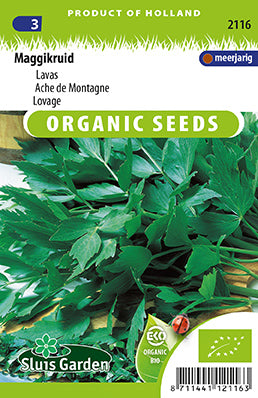1
/
of
1
Lovage BIO
Lovage BIO
Regular price
1.350 KWD
Regular price
Sale price
1.350 KWD
Unit price
/
per
Shipping calculated at checkout.
Couldn't load pickup availability
Growing Lovage (Levisticum officinale) BIO, also known as organic lovage, involves following natural and sustainable practices without the use of synthetic chemicals. Here's a step-by-step guide to help you grow organic Lovage:
**1. Soil Preparation:**
- Choose well-draining soil enriched with organic matter. Lovage prefers fertile, loamy soil with a pH between 6.5 and 7.5.
**2. Planting:**
- **Timing:** Directly sow Lovage seeds in the garden in early spring or late fall. Lovage can also be propagated from root divisions.
- **Spacing:** Sow seeds or plant divisions about 18 to 24 inches apart in rows spaced at least 24 inches apart.
**3. Sunlight:**
- Lovage prefers full sunlight but can tolerate partial shade. Plant it in a location where it receives at least 4-6 hours of direct sunlight daily.
**4. Watering:**
- Keep the soil consistently moist, especially during dry periods. Lovage prefers slightly moist soil.
**5. Mulching:**
- Apply organic mulch, such as straw or shredded leaves, around the base of Lovage plants to retain soil moisture and suppress weeds.
**6. Fertilization:**
- Lovage is not a heavy feeder. You can incorporate well-rotted compost into the soil before planting, and additional fertilization may not be necessary.
**7. Companion Planting:**
- Lovage is a beneficial companion plant for many vegetables. It may attract beneficial insects and repel certain pests.
**8. Pest Control:**
- Lovage is generally resistant to pests. Monitor for aphids and caterpillars, and use organic solutions like insecticidal soap or neem oil if necessary.
**9. Disease Prevention:**
- Lovage is resistant to many diseases. Good garden hygiene and proper spacing can help prevent issues.
**10. Harvesting:**
- Harvest Lovage leaves when the plant is about 12 inches tall. Use clean scissors or garden shears to cut the leaves. Harvest seeds when they are fully mature and have turned brown.
**11. Culinary Uses:**
- Use fresh Lovage leaves in soups, stews, salads, and as a flavoring for sauces. The seeds can be used as a spice.
**12. Pruning:**
- Prune Lovage plants regularly to encourage bushier growth. Pinch the tips or cut back the stems to promote a fuller appearance.
**13. Container Growing:**
- Lovage can be grown in containers. Choose a well-draining potting mix, and make sure the container has drainage holes.
**14. Organic Certification:**
- If you wish to officially label your Lovage as organic, follow the guidelines and requirements set by your local organic certification body.
Growing organic Lovage BIO involves creating a healthy and sustainable environment for your plants, promoting biodiversity, and avoiding synthetic inputs. Following these practices will contribute to the overall well-being of your garden and the quality of your Lovage harvest.
**1. Soil Preparation:**
- Choose well-draining soil enriched with organic matter. Lovage prefers fertile, loamy soil with a pH between 6.5 and 7.5.
**2. Planting:**
- **Timing:** Directly sow Lovage seeds in the garden in early spring or late fall. Lovage can also be propagated from root divisions.
- **Spacing:** Sow seeds or plant divisions about 18 to 24 inches apart in rows spaced at least 24 inches apart.
**3. Sunlight:**
- Lovage prefers full sunlight but can tolerate partial shade. Plant it in a location where it receives at least 4-6 hours of direct sunlight daily.
**4. Watering:**
- Keep the soil consistently moist, especially during dry periods. Lovage prefers slightly moist soil.
**5. Mulching:**
- Apply organic mulch, such as straw or shredded leaves, around the base of Lovage plants to retain soil moisture and suppress weeds.
**6. Fertilization:**
- Lovage is not a heavy feeder. You can incorporate well-rotted compost into the soil before planting, and additional fertilization may not be necessary.
**7. Companion Planting:**
- Lovage is a beneficial companion plant for many vegetables. It may attract beneficial insects and repel certain pests.
**8. Pest Control:**
- Lovage is generally resistant to pests. Monitor for aphids and caterpillars, and use organic solutions like insecticidal soap or neem oil if necessary.
**9. Disease Prevention:**
- Lovage is resistant to many diseases. Good garden hygiene and proper spacing can help prevent issues.
**10. Harvesting:**
- Harvest Lovage leaves when the plant is about 12 inches tall. Use clean scissors or garden shears to cut the leaves. Harvest seeds when they are fully mature and have turned brown.
**11. Culinary Uses:**
- Use fresh Lovage leaves in soups, stews, salads, and as a flavoring for sauces. The seeds can be used as a spice.
**12. Pruning:**
- Prune Lovage plants regularly to encourage bushier growth. Pinch the tips or cut back the stems to promote a fuller appearance.
**13. Container Growing:**
- Lovage can be grown in containers. Choose a well-draining potting mix, and make sure the container has drainage holes.
**14. Organic Certification:**
- If you wish to officially label your Lovage as organic, follow the guidelines and requirements set by your local organic certification body.
Growing organic Lovage BIO involves creating a healthy and sustainable environment for your plants, promoting biodiversity, and avoiding synthetic inputs. Following these practices will contribute to the overall well-being of your garden and the quality of your Lovage harvest.

